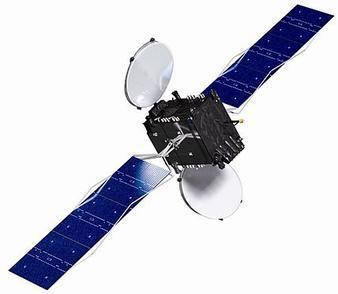 | ||
The STAR-2 Bus is a fully redundant, flight-proven, spacecraft bus designed for geosynchronous missions.
Contents
- Advantages
- Design
- Payload support
- Mission list
- Core bus features
- Structure
- Power subsystem
- Attitude control subsystem
- Command and data handling subsystem
- Shared launch opportunities
- Mission services
- Heritage
- Versatility
- References
It is a satellite platform manufactured by Orbital Sciences Corporation with an apogee kick motor to place a communications satellite into geostationary orbit, a thruster to provide the satellite with orbital station-keeping for a 15-year mission, and solar arrays to provide the satellite payload with 5 kW of electrical power.
Advantages
Orbital's GEOStar-2 Bus design is unique within the satellite industry. Orbital’s GEOStar-2 Bus provides an affordable low-to-medium power satellite platform that is ideal for missions of this size. Rather than being a less efficient version of a larger, heavier product, Orbital’s GEOStar-2 Bus is designed specifically for the 1,000 to 5,550 watts payload class. The GEOStar-2 Bus is flight-proven with excellent operational performance among the 29 currently in-orbit. With two more GEOStar-2 satellites now in production or awaiting launch, Orbital has established its class of GEO satellite products as the unquestioned market leader.
Design
The GEOStar-2 Bus satellite is a modular, mass efficient structure, designed for simplified integration to reduce manufacturing cycle times. The structure is supported by a composite thrust cylinder, to which the bus, payload, nadir and base panels are connected. Energy from two multi-panel solar wings and lithium ion batteries is electronically processed to provide 36 volts regulated power to the satellite throughout the mission. All active units aboard the satellite are connected through a 1553 data bus. Commands and telemetry are processed through the flight software resident on the flight processor, which provides robust autonomous control to all GEOStar-2 satellites. The modularity of the structure and the standard 1553 interfaces allow parallel assembly and test of the bus and payload systems, reducing manufacturing schedule risk by minimizing the time spent in serial satellite integration and test flow.
Payload support
While primary applications are Fixed Satellite Services (FSS) and Broadcast Satellite Services (BSS), the GEOStar-2 Bus can be adapted for MSS, Earth and space science applications, as well as for technology demonstration or risk reduction programs. Depending on mission duration requirements, the GEOStar-2 Bus can accommodate payloads in excess of 500 kilograms, and provide up to 5,550 watts of power. Instrument data can be provided in standard format such as CCSDS or through secured encryption, as approved by the National Security Agency (NSA).
Mission list
Core bus features
Structure
Power subsystem
Attitude control subsystem
Command and data handling subsystem
Shared launch opportunities
Due to the size and mass envelope of the satellite, the GEOStar-2 Bus is compatible with almost all commercially available launch vehicles, maximizing opportunity for launch and access to space. While dedicated or single launch services are more readily available, the GEOStar-2 Bus targets shared launch opportunities, where launch cost and launch-sharing opportunities are favorable.
Mission services
Customers can purchase the GEOStar-2 Bus spacecraft bus alone, or as part of a turn-key service that includes an integrated payload, network operations center and launch vehicle. Orbital conducts spacecraft commissioning from its own ground station prior to transferring spacecraft control to the customer’s operations center.
Heritage
The GEOStar-2 Bus fills a market niche for small, high power geosynchronous communications spacecraft. Orbital’s first application of the GEOStar-2 Bus design, N-STAR c, was successfully launched in July 2002 on an Ariane rocket. Since then, Orbital has launched 27 GEOStar-2 Bus spacecraft with three in production.
Versatility
Several available options augment the basic bus to provide improved pointing, more payload power, secure communications, higher downlink data rates or enhanced payload computing power.
